Review on Wearable Technology Sensors Used in Consumer Sport Applications
Abstract
1. Introduction
1.1. Overview of Technology
1.2. Market
2. Sensors
2.1. Microcontroller
2.2. Accelerometer
2.3. Gyroscopes
2.4. Magnetometers
2.5. Global Positioning System (GPS)
2.6. Heart Rate Sensors
2.7. Pedometers
2.8. Pressure Sensors
3. Electronic Applications
3.1. Important Factors
3.2. Sensor Calculations
- s[t]: distance is a function of time,
- v[t] = S’[t]: velocity becomes a function of time (differentiating distance once),
- a[t] = v’[t]: acceleration becomes a function of velocity (differentiating velocity once),
- a[t] = v’[t] = s’’[t]: acceleration becomes a function of distance (differentiating distance twice).
3.3. Sport Consumer Wearables
3.4. Monitored Data
3.5. Injury Tracking
4. Review
Acknowledgments
Conflicts of Interest
References
- Hatton, L. Industry Analysis: Wearable Technology. Available online: https://www.csus.edu/indiv/h/hattonl/documents/WearableIndustry.docx (accessed on 12 January 2019).
- Creasey, S. Wearable Technology Will Up The Game For Sports Data Analytics. Available online: https://www.computerweekly.com/feature/Wearable-technology-will-up-the-game-for-sports-data-analytics (accessed on 20 October 2018).
- Hinch, W. 8 Technology Trends Driving the Sports Industry. Blog.pitchero.com. 2017. Available online: https://blog.pitchero.com/8-technology-trends-driving-the-sports-industry (accessed on 20 October 2018).
- Mardonova, M.; Choi, Y. Review of Wearable Device Technology and Its Applications to the Mining Industry. Energies 2018, 11, 547. [Google Scholar] [CrossRef]
- Fitbit. Our Technology. Available online: https://www.fitbit.com/uk/technology (accessed on 20 October 2018).
- Kalantari, M. Consumers’ adoption of wearable technologies: Literature review, synthesis, and future research agenda. Int. J. Technol. Mark. 2017, 12, 274–307. [Google Scholar] [CrossRef]
- Papi, E.; Koh, W.S.; McGregor, A.H. Wearable technology for spine movement assessment: A systematic review. J. Biomech. 2017, 64, 186–197. [Google Scholar] [CrossRef] [PubMed]
- Beecham Research. Wearable Technology Application Chart: Beecham Research. Available online: http://www.beechamresearch.com/article.aspx?id=20 (accessed on 24 October 2018).
- Kamisalic, A.; Fister, I.; Turkanovic, M.; Karakatic, S. Sensors and Functionalities of Non-Invasive Wrist-Wearable Devices: A Review. Sensors 2018, 18, 1714. [Google Scholar] [CrossRef] [PubMed]
- Randell, C. Wearable Computing: A Review; Research Gate Department of Computer Science, University of Bristol: Bristol, UK, 2005. [Google Scholar]
- Karim. ICT; Wearable Technology—KARIM Foresight Report; KARIM Foresight Report, Karim Project; European Union: Brussels, Belgium, 2014. [Google Scholar]
- Grand View Research. Wearable Sensors Market Size, Share & Trends Analysis Report by Sensor Type, by Device (Smart Watch, Fitness Band, Smart Glasses, Smart Fabric), by Vertical, by Region, and Segment Forecast, 2018–2025. Available online: https://www.grandviewresearch.com/industry-analysis/global-wearable-sensor-market (accessed on 24 October 2018).
- IDTechEx. Wearable Sensors 2018–2028: Technologies, Markets & Players. Available online: https://www.idtechex.com/research/reports/wearable-sensors-2018-2028-technologies-markets-and-players-000555.asp (accessed on 24 October 2018).
- Ferraro, V. Smart Textiles and Wearable Technologies for Sportswear: A Design Approach, Sensors and Applications; MDPI: Basel, Switzerland, 2015. [Google Scholar]
- Sherman, W.R.; Craig, A.B. Understanding Virtual Reality: Interface, Application, and Design 2003; Morgan Kaufmann: Burlington, MA, USA, 2018. [Google Scholar]
- Nintendo. Create New Ways to Play with Nintendo Labo. Nintendo of Europe GmbH. Available online: https://www.nintendo.co.uk/Nintendo-Labo/Nintendo-Labo-1328637.html (accessed on 28 October 2018).
- Godfrey, A.; Hetherington, V.; Shum, H.; Bonato, P.; Lovell, N.H.; Stuart, S. From A to Z: Wearable technology explained. Maturitas 2018, 113, 40–47. [Google Scholar] [CrossRef]
- Lee, J.; Kim, D.; Ryoo, H.; Shin, B. Sustainable wearables: Wearable technology for enhancing the quality of human life. Sustainability 2016, 8, 466. [Google Scholar] [CrossRef]
- Wearable-Technologies. The Most Successful Wearables for Consumers. Available online: https://www.wearable-technologies.com/2016/01/the-most-successful-wearables-for-consumers/ (accessed on 28 October 2018).
- Ebling, M.R. IoT: From sports to fashion and everything in-between. IEEE Pervasive Comput. 2016, 15, 2–4. [Google Scholar]
- Iqbal, M.H.; Aydin, A.; Brunckhorst, O.; Dasgupta, P.; Ahmed, K. A review of wearable technology in medicine. J. R. Soc. Med. 2016, 109, 372–380. [Google Scholar] [CrossRef]
- Zhou, B.; Koerger, H.; Wirth, M.; Zwick, C.; Martindale, C.; Cruz, H.; Eskofier, B.; Lukowicz, P. Smart soccer shoe: Monitoring foot-ball interaction with shoe integrated textile pressure sensor matrix. In Proceedings of the 2016 ACM International Symposium on Wearable Computers, Heidelberg, Germany, 12–16 September 2016; p. 64. [Google Scholar]
- Anzaldo, D. Wearable sports technology—Market landscape and compute SoC trends. In Proceedings of the 2015 International SoC Design Conference (ISOCC), Gyungju, Korea, 2–5 November 2015; p. 217. [Google Scholar]
- Patel, S.; Park, H.; Bonato, P.; Chan, L.; Rodgers, M. A review of wearable sensors and systems with application in rehabilitation. J. Neuroeng. Rehabil. 2012, 9, 21. [Google Scholar] [CrossRef] [PubMed]
- Awolusi, I.; Marks, E.; Hallowell, M. Wearable technology for personalized construction safety monitoring and trending: Review of applicable devices. Autom. Constr. 2018, 85, 96–106. [Google Scholar] [CrossRef]
- Verle, M. What Are Microcontrollers and What Are They Used for? In Architecture and Programming of 8051 MCUs; MikroElektronika: Belgrade, Serbia, 2009; Available online: https://learn.mikroe.com/ebooks/8051programming/chapter/what-are-microcontrollers-and-what-are-they-used-for/ (accessed on 1 November 2018).
- Reviseomatic Control Systems. Available online: https://reviseomatic.org/help/2-control/Control%20Systems.php (accessed on 1 November 2018).
- Pires, V.M.R.C. Impact of Internet of Everything Technologies in Sports—Football. Ph.D. Thesis, Nova Informational Management School, Instituto Superior de Estatistica e Gestao de Informacao, Universidade Nova de Lisboa, Lisbon, Portugal, 2017. [Google Scholar]
- TechZone360. Four Most In-Demand Programming Languages and Frameworks For Wearables. Available online: https://www.techzone360.com/topics/techzone/articles/2016/07/25/423466-four-most-in-demand-programming-languages-frameworks-wearables.htm (accessed on 15 November 2018).
- Zerynth. Programming Hexiwear Wearable IoT in Python. Available online: https://www.zerynth.com/blog/programming-hexiwear-wearable-iot-in-python-using-zerynth/ (accessed on 15 November 2018).
- Wundersitz, D.W.T.; Josman, C.; Gupta, R.; Netto, K.J.; Gastin, P.B.; Robertson, S. Classification of team sport activities using a single wearable tracking device. J. Biomech. 2015, 48, 3975–3981. [Google Scholar] [CrossRef] [PubMed]
- Live Science. Accelerometers: What They Are & How They Work. Available online: https://www.livescience.com/40102-accelerometers.html (accessed on 15 November 2018).
- Hildeman, A. Classification of Epileptic Seizuresusing Accelerometers. Available online: http://publications.lib.chalmers.se/records/fulltext/145997.pdf (accessed on 15 November 2018).
- Dimension Engineering. A Beginner’s Guide to Accelerometers. Available online: https://www.dimensionengineering.com/info/accelerometers (accessed on 15 November 2018).
- Del Din, S.; Hickey, A.; Hurwitz, N.; Mathers, J.C.; Rochester, L.; Godfrey, A. Measuring gait with an accelerometer-based wearable: Influence of device location, testing protocol and age. Physiol. Meas. 2016, 37, 1785–1797. [Google Scholar] [CrossRef]
- Anuva. A Resource Guide to Wearable Device Sensors. Available online: https://anuva.com/blog/a-resource-guide-to-wearable-device-sensors/ (accessed on 12 October 2018).
- Shodhganga. Accelerometer Theory & Design. Available online: http://shodhganga.inflibnet.ac.in/bitstream/10603/2272/8/08_chapter%202.pdf (accessed on 18 November 2018).
- TE Connectivity. Accelerometer Types. Available online: https://www.te.com/usa-en/industries/sensor-solutions/insights/types-of-accelerometers.html (accessed on 18 November 2018).
- Salazar, A.J.; Silva, A.S.; Borges, C.M.; Correia, M.V. An initial experience in wearable monitoring sport systems. In Proceedings of the 10th IEEE International Conference on Information Technology and Applications in Biomedicine, Corfu, Greece, 3–5 November 2010; p. 1. [Google Scholar]
- Passaro, V.; Cuccovillo, A.; Vaiani, L.; De Carlo, M.; Campanella, C. Gyroscope Technology and Applications: A Review in the Industrial Perspective. Sensors 2017, 17, 2284. [Google Scholar] [CrossRef]
- Sciencing. Types of Gyroscopes. Available online: https://sciencing.com/types-gyroscopes-7329313.html (accessed on 30 November 2018).
- Mitschke, C.; Ohmichen, M.; Milani, T. A Single Gyroscope Can Be Used to Accurately Determine Peak Eversion Velocity during Locomotion at Different Speeds and in Various Shoes. Appl. Sci. 2017, 7, 659. [Google Scholar] [CrossRef]
- Brunner, T.; Lauffenburger, J.; Changey, S.; Basset, M. Magnetometer-augmented IMU simulator: In-depth elaboration. Sensors 2015, 15, 5293–5310. [Google Scholar] [CrossRef]
- Aughey, R.J.; Falloon, C. Real-time versus post-game GPS data in team sports. J. Sci. Med. Sport 2010, 13, 348–349. [Google Scholar] [CrossRef]
- Castaneda, D.; Ghamari, M.; Esparza, A.; Soltanpur, C.; Nazeran, H. A review on wearable photoplethysmography sensors and their potential future applications in health care. Int. J. Biosens. Bioelectron. 2018, 4, 195. [Google Scholar]
- Tamura, T.; Maeda, Y.; Sekine, M.; Yoshida, M. Wearable Photoplethysmographic Sensors—Past and Present. Electronics 2014, 3, 282–302. [Google Scholar] [CrossRef]
- World Health Organization. Using Pulse Oximeters. Available online: https://www.who.int/patientsafety/safesurgery/pulse_oximetry/who_ps_pulse_oxymetry_tutorial1_the_basics_en.pdf (accessed on 3 December 2018).
- Zhao, N. Full-Featured Pedometer Design Realized with 3-Axis Digital Accelerometer. Analog. Dialogue 2010, 44, 1–5. [Google Scholar]
- Explain That Stuff. How Do Pedometers Work? Available online: https://www.explainthatstuff.com/how-pedometers-work.html (accessed on 3 December 2018).
- Husted, H.M.; Llewellyn, T.L. The Accuracy of Pedometers in Measuring Walking Steps on a Treadmill in College Students. Int. J. Exerc. Sci. 2017, 10, 146. [Google Scholar]
- Omega. Theory of Operation of Pressure Sensors. Available online: https://www.omega.co.uk/technical-learning/sensor-theory-of-operation.html (accessed on 6 December 2018).
- Hegde, N.; Bries, M.; Sazonov, E. A Comparative Review of Footwear-Based Wearable Systems. Electronics 2016, 5, 48. [Google Scholar] [CrossRef]
- Lou, C.; Wang, S.; Liang, T.; Pang, C.; Huang, L.; Run, M.; Liu, X. A Graphene-Based Flexible Pressure Sensor with Applications to Plantar Pressure Measurement and Gait Analysis. Materials 2017, 10, 1068. [Google Scholar] [CrossRef]
- Vandrico. Wearable Technology Database. Available online: https://vandrico.com/wearables/ (accessed on 6 December 2018).
- Masse, F.; Gonzenbach, R.; Paraschiv-Ionescu, A.; Luft, A.R.; Aminian, K. Wearable barometric pressure sensor to improve postural transition recognition of mobility-impaired stroke patients. IEEE Trans. Neural Syst. Rehabil. Eng. 2016, 24, 1210–1217. [Google Scholar] [CrossRef]
- Moncada-Torres, A.; Leuenberger, K.; Gonzenbach, R.; Luft, A.; Gassert, R. Activity classification based on inertial and barometric pressure sensors at different anatomical locations. Physiol. Meas. 2014, 35, 1245. [Google Scholar] [CrossRef] [PubMed]
- Bosch Sensortec. Wearable Applications. Available online: https://www.bosch-sensortec.com/bst/applicationssolutions/wearables/overview_wearables (accessed on 8 December 2018).
- De Arriba-Pérez, F.; Caeiro-Rodríguez, M.; Santos-Gago, J.M. Collection and processing of data from wrist wearable devices in heterogeneous and multiple-user scenarios. Sensors 2016, 16, 1538. [Google Scholar] [CrossRef] [PubMed]
- Jovanov, E.; Milenkovic, A.; Otto, C.; De Groen, P.C. A wireless body area network of intelligent motion sensors for computer assisted physical rehabilitation. J. Neuroeng. Rehabil. 2005, 2, 6. [Google Scholar] [CrossRef] [PubMed]
- Soderholm, T. 6 wireless technologies for wearables. Available online: https://blog.nordicsemi.com/getconnected/wireless-technologies-for-wearables (accessed on 4 January 2019).
- Augur, H. Comparing RFID and Bluetooth Tags. Available online: https://kontakt.io/blog/comparing_rfid_and_bluetooth_tags/ (accessed on 4 January 2019).
- Lin, J.; Talty, T.; Tonguz, O. On the potential of bluetooth low energy technology for vehicular applications. IEEE Commun. Mag. 2015, 53, 267–275. [Google Scholar] [CrossRef]
- Shrestha, B. Measurement of Power Consumption of Bluetooth Low Energy [BLE]. Available online: https://www.theseus.fi/bitstream/handle/10024/118662/Shrestha_Bikash.pdf?sequence=1&isAllowed=y (accessed on 4 January 2019).
- Yuan, Y.; Chen, C.; Guan, X.; Yang, Q. An energy-efficient underground localization system based on heterogeneous wireless networks. Sensors 2015, 15, 12358–12376. [Google Scholar] [CrossRef]
- CCM. Introduction to Wi-Fi [802.11 or WiFi]. Available online: https://ccm.net/contents/802-introduction-to-wi-fi-802-11-or-wifi (accessed on 4 January 2019).
- Doukas, C.; Maglogiannis, I. Advanced Patient or Elder Fall Detection based on Movement and Sound Data. In Proceedings of the 2008 Second International Conference on Pervasive Computing Technologies for Healthcare, Tampere, Finland, 30 January–1 February 2008. [Google Scholar]
- An, B.; Shin, J.; Kim, S.; Kim, J.; Ji, S.; Park, J.; Lee, Y.; Jang, J.; Park, Y.; Cho, E.; et al. Smart Sensor Systems for Wearable Electronic Devices. Polymers 2017, 9, 303. [Google Scholar] [CrossRef] [PubMed]
- Ovrebekk, T. The Importance of Average Power Consumption to Battery Life. Available online: https://blog.nordicsemi.com/getconnected/the-importance-of-average-power-consumption-to-battery-life (accessed on 4 January 2019).
- Maxim Integrated. Wearable Weight Loss—Slim Down Wellness Devices with Better Energy Efficiency. Available online: https://www.maximintegrated.com/en/app-notes/index.mvp/id/5949 (accessed on 10 January 2019).
- Kuruganti, T. Low-cost Wireless Sensors for Building Monitoring Applications; Oak Ridge National Laboratory, Building Technologies Office Peer Review, U.S. Department of Energy: Washington, DC, USA, 2014.
- Kong, L.B.; Li, T.; Hng, H.H.; Boey, F.; Zhang, T.; Li, S. Waste mechanical energy harvesting (I): Piezoelectric effect. Lect. Notes Energy 2014, 24, 19–133. [Google Scholar]
- James, D.A.; Petrone, N. Sensors and Wearable Technologies in Sport: Technologies, Trends and Approaches for Implementation; Springer: Berlin/Heidelberg, Germany, 2016; pp. 1–49. ISBN 9789811009914. [Google Scholar]
- Zepp. Sensors to Take Your Game to the Next Level. Available online: https://www.zepp.com/en-us/# (accessed on 24 October 2018).
- Broadbent, D. Performance Analysis in Football: Feedback; Lecture Notes; Department of Life Sciences, Brunel University London: London, UK, 2017. [Google Scholar]
- Ferguson, A. How Accurate Are Wearables? Available online: https://www.athleticbusiness.com/equipment/how-accurate-are-wearables.html (accessed on 28 February 2019).
- El-Amrawy, F.; Nounou, M.I. Are Currently Available Wearable Devices for Activity Tracking and Heart Rate Monitoring Accurate, Precise, and Medically Beneficial? Healthc. Inform. Res. 2015, 21, 315–320. [Google Scholar] [CrossRef] [PubMed]
- Xie, J.; Wen, D.; Liang, L.; Jia, Y.; Gao, L.; Lei, J. Evaluating the Validity of Current Mainstream Wearable Devices in Fitness Tracking Under Various Physical Activities: Comparative Study. JMIR Mhealth Uhealth 2018, 6, e94. [Google Scholar] [CrossRef]
- Murakami, H.; Kawakami, R.; Nakae, S.; Nakata, Y.; Ishikawa-Takata, K.; Tanaka, S.; Miyachi, M. Accuracy of Wearable Devices for Estimating Total Energy Expenditure: Comparison with Metabolic Chamber and Doubly Labeled Water Method. JAMA Intern. Med. 2016, 176, 702–703. [Google Scholar] [CrossRef] [PubMed]
- Shin, G.; Jarrahi, M.H.; Fei, Y.; Karami, A.; Gafinowitz, N.; Byun, A.; Lu, X. Wearable Activity Trackers, Accuracy, Adoption, Acceptance and Health Impact: A Systematic Literature Review. J. Biomed. Inform. 2016, 93, 103153. [Google Scholar] [CrossRef] [PubMed]
- Hildenbrand, J. Andoird Central, Smartwatches are awesome. So Why Aren’t They More Popular? Available online: https://www.androidcentral.com/whats-wrong-wearables (accessed on 28 February 2019).
- Endeavour Partners. Inside Wearables—Part 2. Available online: https://digitalwellbeing.org/wp-content/uploads/2015/11/2014-Inside-Wearables-Part-2-July-2014.pdf (accessed on 28 February 2019).
- Asimakopoulos, S.; Asimakopoulos, G.; Spillers, F. Motivation and User Engagement in Fitness Tracking: Heuristics for Mobile Healthcare Wearables. Informatics 2017, 4, 5. [Google Scholar] [CrossRef]
- Fritz, T.; Huang, E.M.; Murphy, G.C.; Zimmermann, T. Persuasive Technology in the Real World: A Study of Long-Term Use of Activity Sensing Devices for Fitness. In Proceedings of the SIGCHI Conference on Human Factors in Computing Systems, Toronto, ON, Canada, 26 April–1 May 2014. [Google Scholar]
- Mao, A.; Ma, X.; He, Y.; Luo, J. Highly Portable, Sensor-Based System for Human Fall Monitoring. Sensors 2017, 17, 2096. [Google Scholar] [CrossRef] [PubMed]
- Majumder, S.; Mondal, T.; Deen, M.J. Wearable sensors for remote health monitoring. Sensors 2017, 17, 130. [Google Scholar] [CrossRef]
- Quan, W.; Wang, H.; Liu, D. A multifunctional joint angle sensor with measurement adaptability. Sensors 2013, 13, 15274–15289. [Google Scholar] [CrossRef]
- Ryall, J. Samsung Creates Headgear Prototype to Help Monitor Concussions in Sports. Available online: http://mashable.com/2016/03/22/samsung-concussion-tech/#ah1i4MtjNPq6 (accessed on 24 October 2018).
- Newatlas. Smartfoam Helmets Could Help NFL Coaches Diagnose Concussions. Available online: https://newatlas.com/nfl-concussion-cte-smartfoam-helmet-sensor/51465/ (accessed on 8 February 2019).
- Makhni, E.; Lizzio, V.; Meta, F.; Stephens, J.; Okoroha, K.; Moutzouros, V. Assessment of Elbow Torque and Other Parameters During the Pitching Motion: Comparison of Fastball, Curveball, and Change-up. Arthrosc. J. Arthrosc. Relat. Surg. 2018, 34, 816–822. [Google Scholar] [CrossRef] [PubMed]
- Nagano, H.; Begg, R. Shoe-Insole Technology for Injury Prevention in Walking. Sensors 2018, 18, 1468. [Google Scholar] [CrossRef] [PubMed]
- Pollack, K.M.; D’angelo, J.; Green, G.; Conte, S.; Fealy, S.; Marinak, C.; McFarland, E.; Curriero, F.C. Developing and Implementing Major League Baseball’s Health and Injury Tracking System. Am. J. Epidemiol. 2016, 183, 490–496. [Google Scholar] [CrossRef]
- Edger, M. Letting Go of Errors and Mistakes. Available online: http://www.sportpsychologytoday.com/youth-sports-psychology/letting-go-of-errors-and-mistakes/ (accessed on 6 January 2019).
- Govus, A.D.; Coutts, A.; Duffield, R.; Murray, A.; Fullagar, H. Relationship between Pre-Training Subjective Wellness Measures, Player Load and Rating of Perceived Exertion Training Load in American College Football. Int. J. Sports Physiol. Perform. 2018, 13, 95–101. [Google Scholar] [CrossRef] [PubMed]
- Esmaeili, A.; Stewart, A.M.; Hopkins, W.G.; Elias, G.P.; Lazarus, B.H.; Rowell, A.E.; Aughey, R.J. Normal Variability of Weekly Musculoskeletal Screening Scores and the Influence of Training Load across an Australian Football League Season. Front. Physiol. 2018, 9, 144. [Google Scholar] [CrossRef] [PubMed]
- Williams, S.; West, S.; Cross, M.J.; Stokes, K.A. Better way to determine the acute: Chronic workload ratio? Br. J. Sports Med. 2017, 51, 209–210. [Google Scholar] [CrossRef] [PubMed]
- The National Archives. Provisional Monthly HES Topic of Interest: A&E Sports Injury Attendances. Available online: http://content.digital.nhs.uk/catalogue/PUB06857/prov-mont-hes-admi-outp-ae-apr-feb-12-toi-rep.pdf (accessed on 28 October 2018).
- Drew, M.K.; Purdam, C. Time to bin the term ‘overuse’ injury: Is ‘training load error’ a more accurate term? Br. J. Sports Med. 2016, 50, 1423–1424. [Google Scholar] [CrossRef] [PubMed]
- Health Harvard. The Importance of Stretching. Available online: http://www.health.harvard.edu/staying-healthy/the-importance-of-stretching (accessed on 20 October 2018).
- Bowen, L.; Gross, A.S.; Gimpel, M.; Li, F. Accumulated workloads and the acute: Chronic workload ratio relate to injury risk in elite youth football players. Br. J. Sports Med. 2017, 51, 452–459. [Google Scholar] [CrossRef]
- Taylor, D.J.; Tillman, T.J.; Zadeh, A.; Bruce, S.L.; Bertsos, M.L.; DiMasso, A.E.; Marshall, D.L. The use of wearable technologies for injury prediction. In Proceedings of the Celebration of Research, Scholarship, and Creative Activities, Wright State University, Dayton, OH, USA, 21 April 2017. [Google Scholar]
- Hulin, B.T.; Gabbett, T.J.; Lawson, D.W.; Caputi, P.; Sampson, J.A. The acute: Chronic workload ratio predicts injury: High chronic workload may decrease injury risk in elite rugby league players. Br. J. Sports Med. 2016, 50, 231–236. [Google Scholar] [CrossRef]
- Cross, M.J.; Williams, S.; Trewartha, G.; Kemp, S.P.; Stokes, K.A. The Influence of In-Season Training Loads on Injury Risk in Professional Rugby Union. Int. J. Sports Physiol. Perform. 2016, 11, 350–355. [Google Scholar] [CrossRef]
- Hennig, E.M.; Sterzing, T. The influence of soccer shoe design on playing performance: A series of biomechanical studies. Footwear Sci. 2010, 2, 3–11. [Google Scholar] [CrossRef]
- Injury Prevention Using Statsports. An ounce of prevention is worth a pound of Cure. Available online: https://statsports.com/injury-prevention-using-statsports-viper/ (accessed on 24 October 2018).


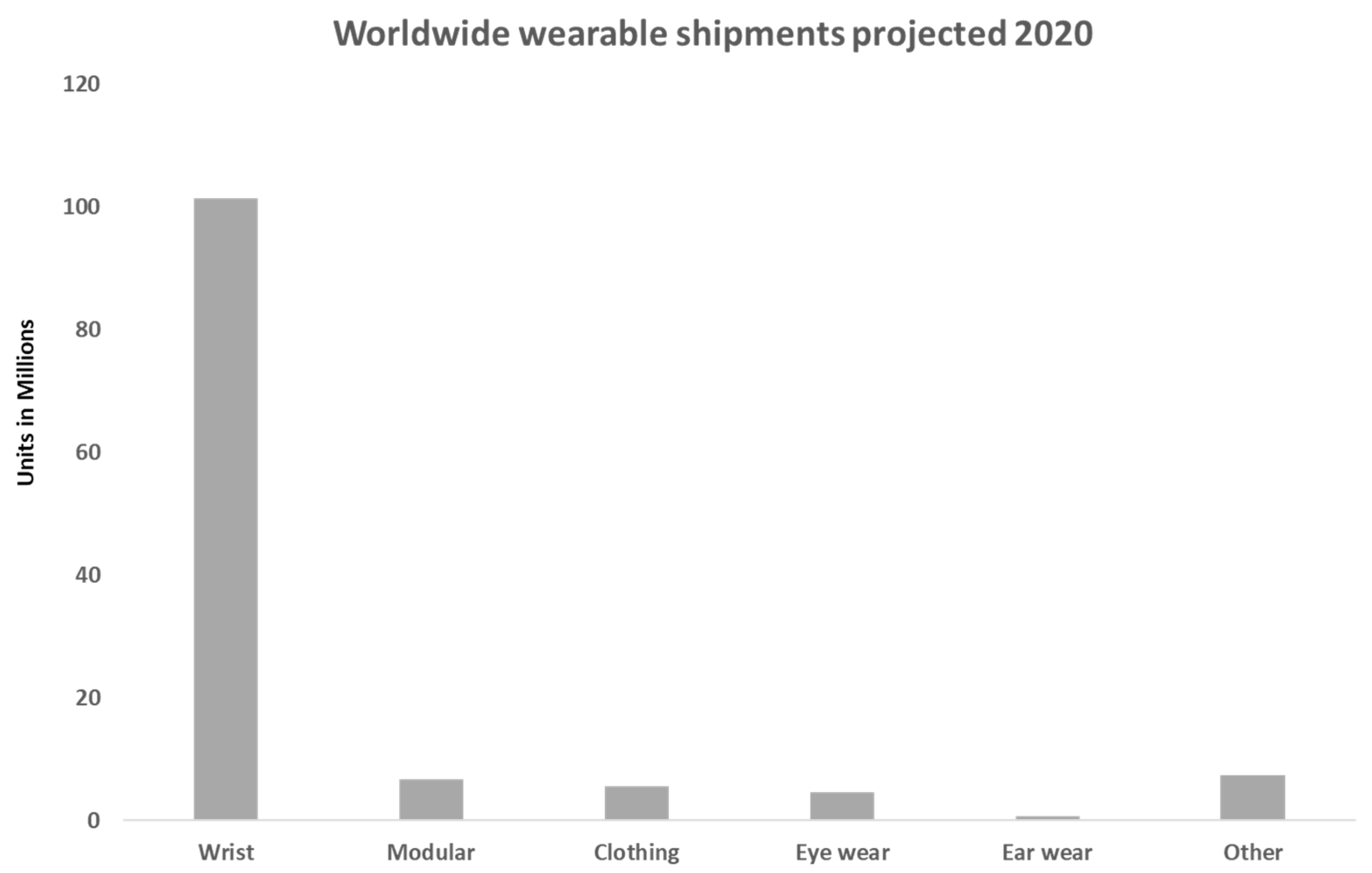
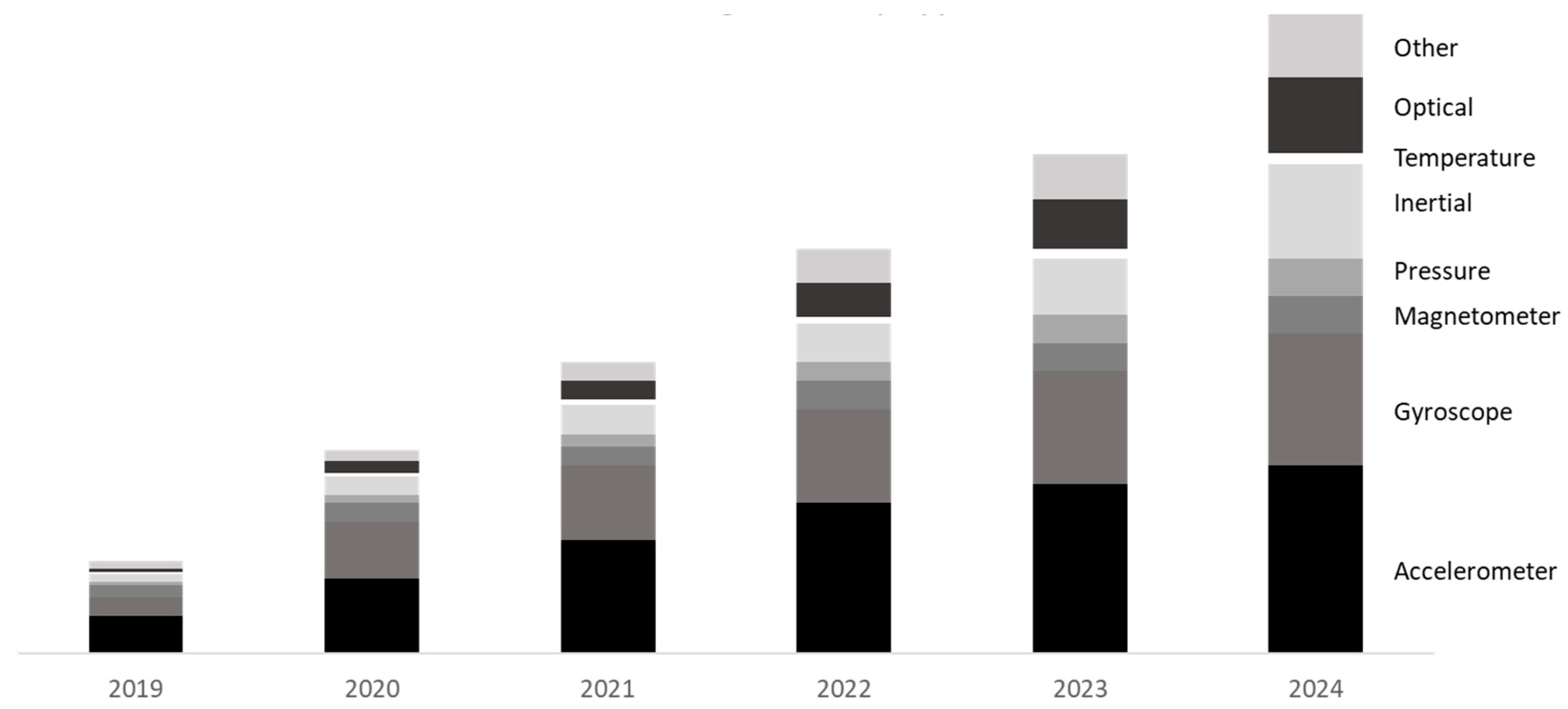
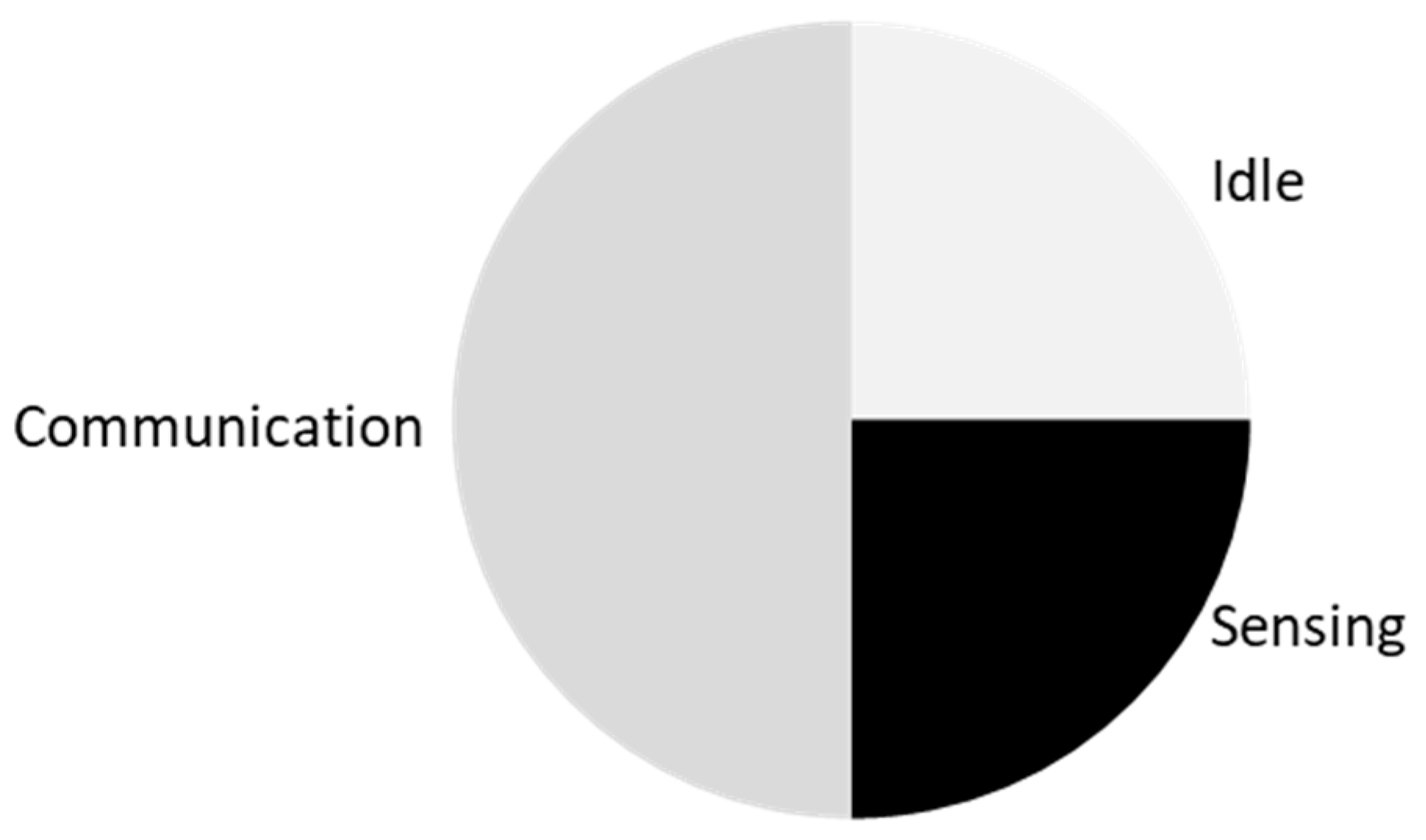
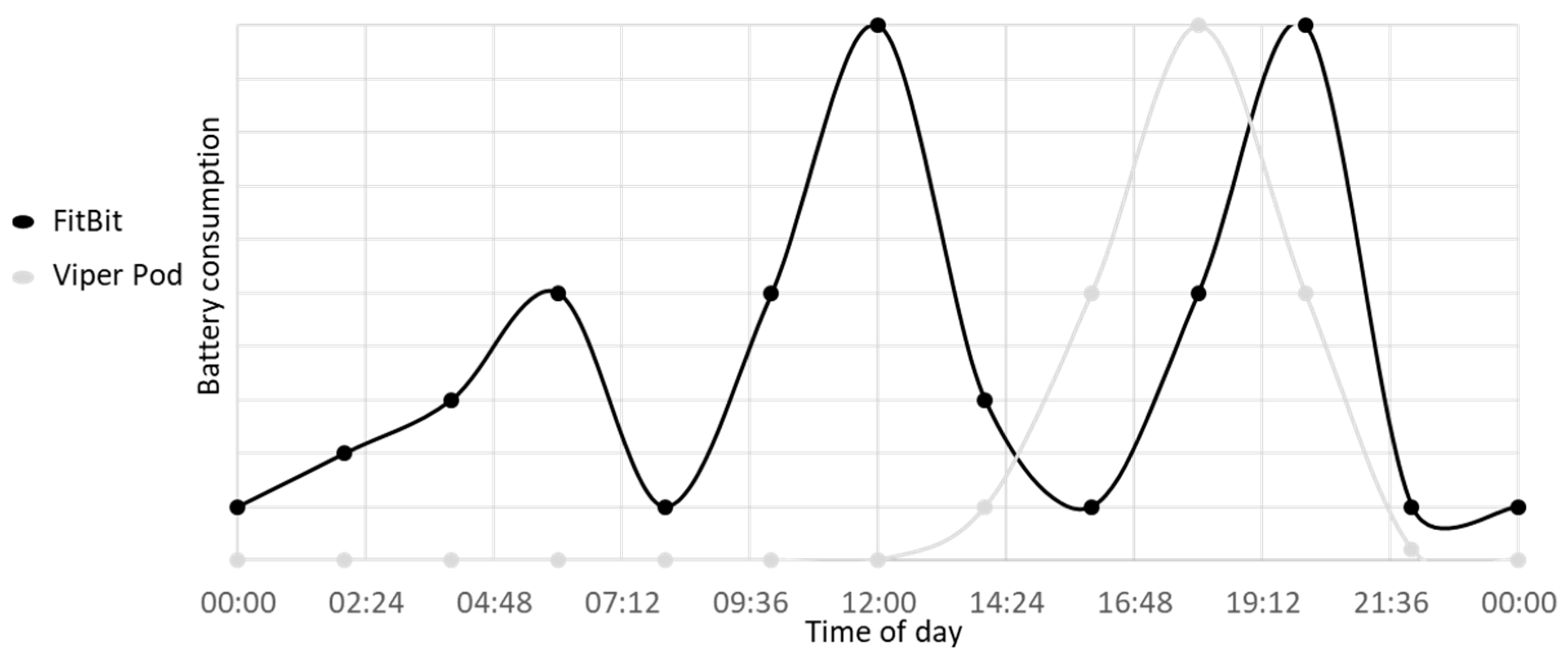
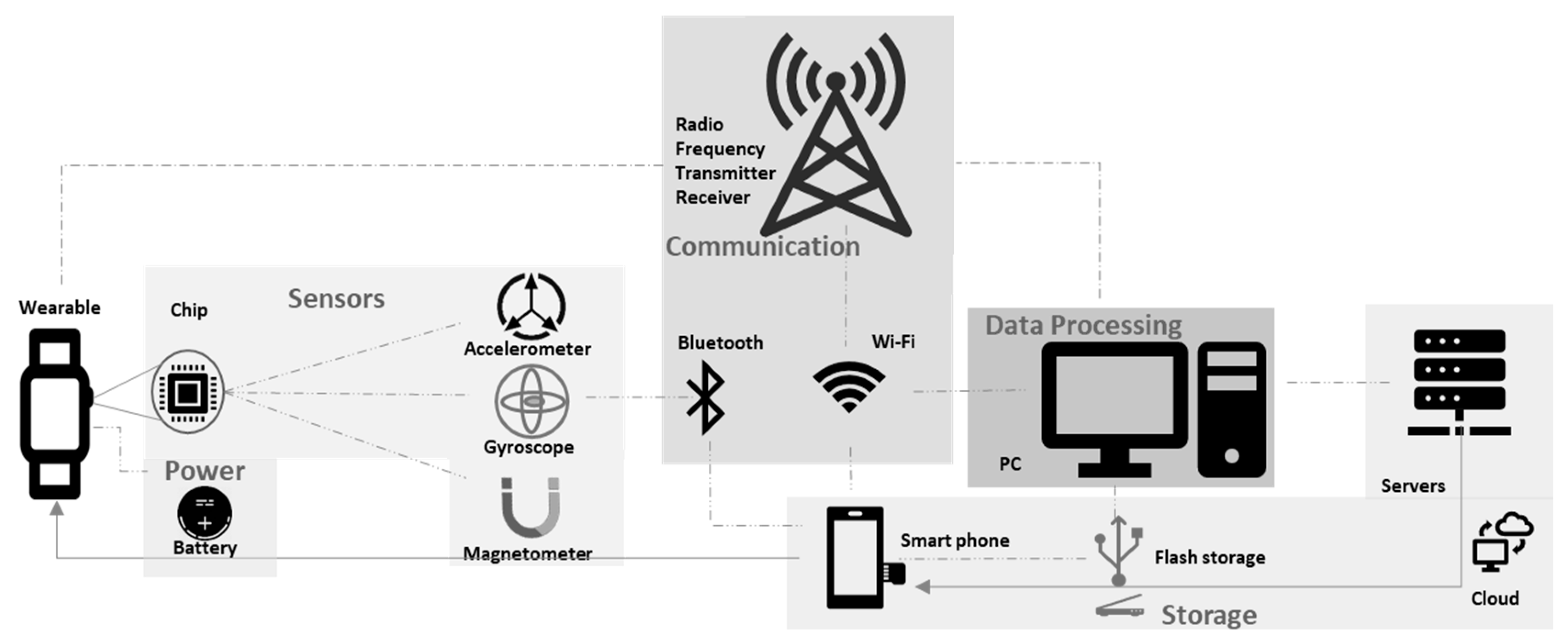
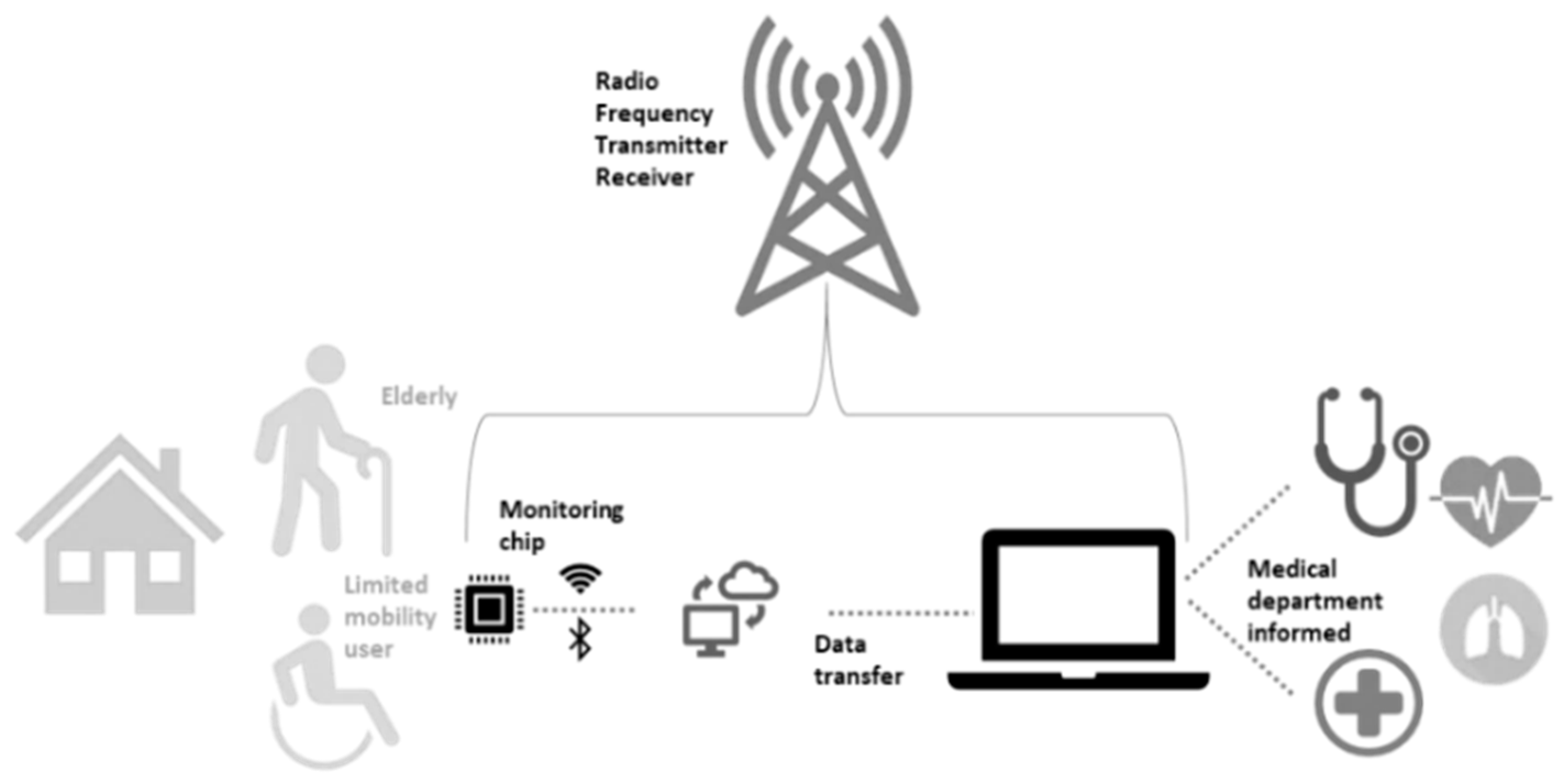

| Wearable | Accelerometer | Gyroscope | Heart Rate Monitor | GPS | Smart Category | Application | Body Place | Other Sensors |
|---|---|---|---|---|---|---|---|---|
| Apple Watch 2 | x | x | x | Watch | Lifestyle | Wrist | Speaker | |
| Fitbit | x | x | x | Watch | Fitness | Wrist | Photodiode | |
| Nintendo Joycon | x | x | Controller (modular) | Gaming | Hand * | IR sensor, NFC | ||
| PlayStation VR | x | x | Eye wear | Gaming | Head | Microphone, speaker | ||
| OM Bra | x | x | x | Clothing | Medical | Upper body | Pedometer | |
| RealWear HMT | x | x | x | Ear wear | Industrial | Head | Microphone, Speaker, camera | |
| HexoSkin | x | x | Clothing | Fitness | Upper body | Pedometer, ECG sensor, Thermometer | ||
| Vuzix AR3000 | x | x | x | Headwear | Medical | Head | Camera, Magnetometer, microphone | |
| Google Glass | x | x | x | Eye wear | Industrial | Head | Magnetometer, microphone, speaker, light sensors, IR sensor, Camera | |
| Samsung Gear S3 | x | x | x | x | Watch | Lifestyle | Wrist | Barometer, Light sensor |
| Wireless Technology for Wearables | Cost ($) | Power Consumption | Range (m) | Bandwidth | Bit Rate (Mbit/s) | Physical Size | Wearable Industry |
|---|---|---|---|---|---|---|---|
| Bluetooth LE | 5–35 | Low | ~100 | Low | 0.12–2 | Small | Sport |
| Near Field communication | 25–100 | Low (higher with passive tag) | ~0.2 | Low | 0.4 | Small | Medical Lifestyle |
| Bluetooth classic | 5–35 | Moderate | ~100 | High | 1–3 | Small | Lifestyle |
| ANT | 15–40 | Low | ~30 | Low | 0.12–0.6 | Small | Sport |
| ZigBee | 4–20 | Low | 10–100 | Low | 0.25 | Small | Industrial |
| Wi-Fi | 50–120 | Very high | 10–70 | High | 2–54 | Small | Industrial Lifestyle |
| Wearable | 06:00 | 09:00 | 12:00 | 15:00 | 18:00 | 21:00 | 24:00 | 06:00 |
|---|---|---|---|---|---|---|---|---|
| Fitbit | Wake up | Eaten, travelled to work | Eating lunch, walk outside of work | Been at desk for 2 h (idle) | After Work finished, Workout at Gym | Dinner eaten, resting at home | Already in Sleep | Wake up |
| Viper Pod | Analyzing previous performance | Charging, setting up for today | Training starts | Training finished, analysis feedback |
| Sensor | Acceleration (m/s2) | Velocity (m/s) | Distance (m) | Angular Velocity (rad/s) | Angular Acceleration (rad/s2) | Relative Angle (rad) | Absolute Angle (rad) | Force (N) | Moment (Nm) |
|---|---|---|---|---|---|---|---|---|---|
| Accelerometer | Measured | Derived | Derived (2x) | - | - | - | - | Mass derived | |
| Gyroscope | - | - | - | Measured | Derived | Difference calculated | Integrated | - | Inertia derived |
| Sports Wearable | Accelerometer | Gyroscope | Magnetometer | Heart Rate Monitor | GPS | Position |
|---|---|---|---|---|---|---|
| Fitbit | x | x | x | x | Wrist | |
| Zepp Play | x | x | x | Equipment * | ||
| Lumo Run | x | x | x | Lower back | ||
| Optimeye | x | x | x | Back (Vest) | ||
| PlayerTek | x | x | x | Back (Vest) | ||
| Viper POD | x | x | x | Back (Vest) | ||
| Adidas MiCoach | x | x | Ball |
| Zepp Play | Accelerometer Type | Gyroscope Type | Position | Sport Specific Attributes Tracking |
|---|---|---|---|---|
| Football | 3 axis accelerometers | 3 axis gyroscopes | Calf | Sprints, Distance, Kicks, Top speed, Loads |
| Baseball | Dual accelerometer | Dual 3 axis Gyroscope | Handle of Bat | Bat speed, Accuracy, projectile, hand speed, attack angle, vertical angle, time to impact |
| Golf | Dual Accelerometer | 3 axis gyroscopes | Top of glove | Club speed, Hand plane, Downswing, Backswing, hip rotation, Tempo ratio |
| Tennis | Dual accelerometer | Dual 3 axis gyroscope | Handle of racket | Ball speed, ball spin, serve, forehand/backhand, topspin, drive, active time, calories, slice |
| Attributes IMU Sensor Measures | Football | Athletics | Baseball | Basketball |
|---|---|---|---|---|
| Number of Sprints | Strikers, midfielders | Relay | Base runners | All |
| Vertical acceleration | Forward wings, Full backs | Sprinters, Marathon runners, long jump, high jump | All batters | All |
| Top speed | Strikers, forward wings, wing backs, defenders | All runners | All batters, short stop, outfielders | Power/small forwards |
| Distance | Forwards, midfielders, defenders | Marathon, sprinters, relay | Outfielders | All |
| Intensity Distance | Forwards, defensive midfielders | Sprinters, relay, marathon, heptathlon | Shortstop, outfielders, all batters | All |
| Vertical Jump | Forwards, defenders, goalkeepers | High jump, long jump, hurdles, heptathlon | Outfielders, shortstop, all basemen | All |
| Horizontal jump | Goalkeepers | High jump, Long jump, heptathlon | Short stop, all basemen, catcher | Point guard, post |
| Hand speed | Goalkeepers | Heptathlon, javelin | Power bats, pitchers | Forwards |
| Hip rotation (kick speed) | Power Kick specialists | Javelin, heptathlon | Pitchers | Post |
| Trajectory | All (freekick specialists) | heptathlon | All batters, pitchers | Shooting guard |
| Backswing | Power kick specialists | High jump, long jump, hurdles, heptathlon | All batters | All |
| Forward swing | Power kick specialists | High jump, long jump, hurdles, heptathlon | All batters | All |
| Biomechanical Factors Leading to Injury | Sport | Motion and Possible Injury Example | Sensors |
|---|---|---|---|
| Falls | ALL | Dangerous drop of body weight or collision | IMU |
| Excessive loads on leg (feet, knees) | Football Basketball American football/Rugby Cycling/Athletics Ice hockey/Figure skating | Dangerous running methods Excessive jumping (vertical) Incorrect agile sprints Unbalance loads on feet Dangerous skating elevations | IMU, pressure |
| Excessive load on arm (forearm, biceps, hands) | Boxing Baseball Basketball | Incorrect contact elevation Consecutive fast ball pitching Slam Incorrect pitching balance can lead to loads on joints Dunking too hard | IMU, pressure |
| Stress | ALL | Irregular heart/respiratory rate, blood pressure | Heart rate monitor, IR sensor |
| Arm speed | Tennis Baseball/Golf | Incorrect rapid dangerous incident angle swings Sudden irregular forward swings | Gyroscope, Accelerometer |
| Kick speed | Football/American football/Rugby | Improper technique can lead to cramps | Gyroscope, Accelerometer |
| Angular Collision | American football/Ice hockey/Rugby | Due to tackling nature, concussions occur | Gyroscope, Accelerometer |
| Excessive rotation arm | Baseball Tennis Boxing | rapid curve ball/slider pitching/Backswing motion (batting) Dangerous serving, back hand strokes. Too fast in combinations can exert force incorrectly on joints | Gyroscope, Accelerometer |
| Excessive rotation leg | Cycling Football/Rugby/American Football | Incorrect balance whilst pedalling Vigorous kick elevation can cause muscle strains | Gyroscope, Accelerometer |
| Abnormal body temperature | ALL (water sports included) | Change in body temperature can be due to an accident or environmental conditions | Thermistor GPS |
© 2019 by the authors. Licensee MDPI, Basel, Switzerland. This article is an open access article distributed under the terms and conditions of the Creative Commons Attribution (CC BY) license (http://creativecommons.org/licenses/by/4.0/).
Share and Cite
Aroganam, G.; Manivannan, N.; Harrison, D. Review on Wearable Technology Sensors Used in Consumer Sport Applications. Sensors 2019, 19, 1983. https://doi.org/10.3390/s19091983
Aroganam G, Manivannan N, Harrison D. Review on Wearable Technology Sensors Used in Consumer Sport Applications. Sensors. 2019; 19(9):1983. https://doi.org/10.3390/s19091983
Chicago/Turabian StyleAroganam, Gobinath, Nadarajah Manivannan, and David Harrison. 2019. "Review on Wearable Technology Sensors Used in Consumer Sport Applications" Sensors 19, no. 9: 1983. https://doi.org/10.3390/s19091983
APA StyleAroganam, G., Manivannan, N., & Harrison, D. (2019). Review on Wearable Technology Sensors Used in Consumer Sport Applications. Sensors, 19(9), 1983. https://doi.org/10.3390/s19091983






